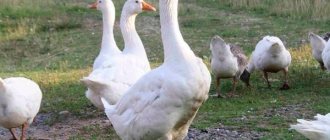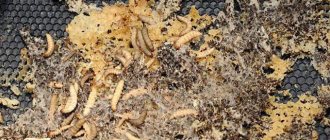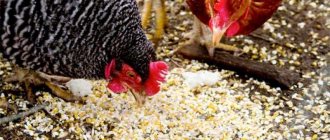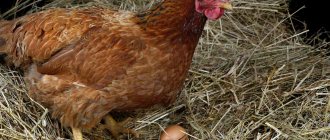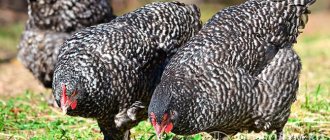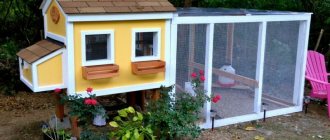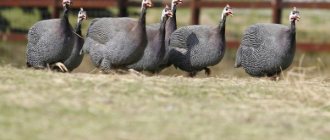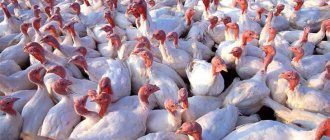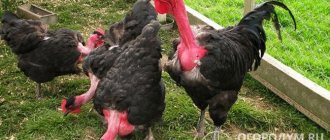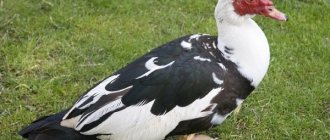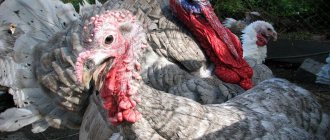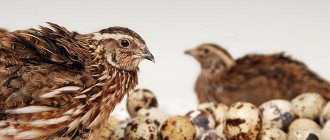Domestic owners do not raise waterfowl as often as chickens. Nevertheless, interest in goose farming has always been consistently high, since this activity makes it relatively easy and quite profitable to provide a family with healthy and very tasty meat products. Many novice poultry farmers are interested in how to choose the breeds of geese that are best suited for keeping in a private backyard.
Young animals gain weight well on pasture in the presence of pasture and pond
We decided to help readers understand this issue and tell us about the most popular and interesting varieties of domestic geese.
Kholmogorskaya
Photo:
Description: One of the most common breeds in Russia, it was bred by crossing Arzamas and Chinese geese. The first mention of it dates back to 1885.
Kholmogory geese have a recognizable appearance due to the massive bump on their beak, which is formed by 5-6 months of life. Depending on the breed line, the beak may be long, medium or short. There is a large goiter under each jaw, making the neck appear underdeveloped.
The body of the bird is massive and powerful, the wings are long and the chest is well formed. Geese of this breed can be white, gray or gray-piebald in color. The legs and beak are orange.
Males can grow up to 10 kg, females are smaller - 7-9 kg.
Egg production is low, the average is 30 eggs per clutch. Sexual maturity occurs only at 3 years of age; females have a poorly developed brooding instinct; due to their heavy weight, they often break the shell.
Kholmogory are distinguished by a kind and calm disposition, they are not prone to aggression, and can get along with other birds in the yard. They are long-lived among geese; with proper care, they can live up to 17 years. They are unpretentious in nutrition and have good resistance to cold.
Brief descriptions of common breeds
We suggest that you familiarize yourself with the economic characteristics of popular goose breeds and find out their main advantages and disadvantages.
"Adlerskaya"
Obtained in the Krasnodar region on the basis of local “gray” varieties. It is considered unpretentious, undemanding to feed, and resistant to hot climates. The bird is medium in size, with a long body and broad chest. The legs and neck are relatively short. The color of the plumage is white, the paws and beak are bright orange. Meat products have excellent taste and low fat content. The growth rate is quite decent: at the age of 70 days, goslings weigh about 4-4.5 kg. Difficulties in breeding and maintenance are associated with low rates of hatching and survival of chicks, as well as with the restless nature of adults.
The egg production of females is at the level of 25-30 eggs per season, 70-80% of them are fertilized, and the hatching of chicks is about 50%
"Arzamas"
It was bred in the 17th century as a fighting dog, but is now used exclusively as meat. A bird of dense build, with a long body, powerful chest and medium-length neck. The plumage is white (can be light gray or cream). The beak and paws are orange. The eyes are large, bright blue with an orange “rim.” The rate of weight gain is high: two-month-old babies weigh about 4 kg. The meat is tasty, juicy, tender, moderately fatty.
The breed is valued for its unpretentiousness, moderate appetite, suitability for grazing, and resistance to cold and disease. The bird is very hardy, easy to breed and keep, especially if there is a summer range. The “Arzamas” goose is the symbol and main attraction of the city of Arzamas, as well as the main “character” of the culinary festival of the same name, which has been held in the Nizhny Novgorod region since 2012.
The disadvantage is considered to be the warlike disposition of the males, because of which the “Arzamas men” have to be kept separately from the rest of the inhabitants of the farmstead
"African"
One of the largest meat breeds of geese, which has gained popularity since the mid-19th century. The reason why they began to call it that way is unknown. It was bred in Southeast Asia on the basis of the genetic material of the Chinese “sukhenos”. The color is fawn, brown or pure white. The beak and the large “bump” above it are black, the paws are orange, and the eyes are brown. Birds can gain a lot of weight, but mature rather slowly: females reach sexual maturity only by two years. In addition, hatchability and survival of young animals are assessed as average, and egg production is generally considered low (about 20 eggs per season). Therefore, the breed is almost never bred commercially. But it is widely used to produce crossbreeds with high meat productivity and good broiler qualities.
“Africans” are not too difficult to keep, but are sensitive to cold and need a heated room for the winter
"Hungarian"
A universal variety brought to the Russian Federation from Western Europe in the late 1980s. Today it is bred mainly in Bashkortostan. The plumage color is white. The bird is famous for its high fattening qualities, the ability to grow well and gain weight while out on the run, and the ability to obtain large and fatty livers (with special fattening and limited mobility). Produces tender meat of excellent taste, feather and down raw materials. Used for making downy skins.
Disadvantages: poor tolerance to low temperatures and dampness, increased susceptibility to certain infectious diseases.
Some individuals grow curly, especially soft feathers; when plucking is carried out 2-4 times a year, 110-120 g of down feather raw material is obtained from each bird
"Vishtines"
Bred in Lithuania, distributed in the Baltic countries. The plumage color is white (less often clay-gray or grey). The beak and paws are orange, the eyes are brown and large. It is valued for the excellent maternal qualities of females, the rapid growth of young animals (a two-month-old gosling weighs 4-4.2 kg), the ability to fatten adults “for the liver” and obtain excellent fluff.
Birds have good health and adapt well to unfavorable external factors; meat yield from the carcass is about 70%, the product is tender and low-fat
"Gorkovskaya" ("Linda")
Obtained in the second half of the 20th century in the Nizhny Novgorod region as a result of complex crossing of representatives of the “Arzamas”, “Land”, “Chinese” and several other breeds. In 1993, it was officially registered in the State Register of the Russian Federation under the name “Lindovskaya”. The plumage color is white (less often gray-piebald or dark gray). The legs and beak are orange. The neck is long and curved. In adults, there is a small knob-like growth above the beak.
The variety is extremely popular not only in Russia, but also in many European countries due to its unpretentiousness, low requirements for feed, resistance to heat and cold, high survival rate and rapid growth of young animals. The maternal instinct in females is well developed, so the bird is considered very convenient for breeding in small farms that do not have incubators .
Among the disadvantages, the high need for water for bathing by “Linda” geese is noted.
If there is no access to a body of water, the bird begins to get sick, and the quality of its meat and down decreases.
"Governor's"
A relatively “young” variety (officially registered in 2011). The color of the feathers and down is white, the beak and paws are reddish-orange. The productivity of the breed is associated with excellent survival rate of young animals and a very high rate of weight gain: by 9 weeks, young males can gain weight up to 4.5 kg. In addition, the bird is characterized by very high feed conversion rates, unpretentiousness and resistance to cold. A big advantage of the “governor” ones is considered to be autosexing, which makes it possible to determine the sex of the chicks in the first days of life.
In the middle zone, “governors” can be kept in unheated rooms all year round
"Danish Legart"
One of the best large breeds, suitable not only for growing “for meat” and “for liver”, but also for obtaining high-quality down raw materials: with regular plucking, about 500 g of down can be obtained from one individual per year. The color of the plumage is snow-white, the beak and paws are red-orange. There is a light (almost white) spot at the end of the beak. The eyes are bright blue. Meat products are distinguished by their delicate taste and high quality. Among the disadvantages, it is worth noting the poorly developed maternal instinct of females and low resistance to cold (in winter, the “Danes” need a heated house).
“Legarts” have a harmonious physique and are valued for their calm, peaceful disposition
"Italian white"
Brought to Russia in the last quarter of the 20th century. The plumage is pure white, the paws and beak are orange, the eyes are blue with an orange “rim.” Despite the “southern” origin, the bird has adapted well to the climate of the middle zone. He has good health and an active but non-aggressive disposition. Can be kept without a pond. With proper feeding, it quickly gains weight. Produces meat products of the highest quality and large (about 7% live weight) fatty liver. Widely used for crossing with “heavier” breeds in order to breed crosses with high meat productivity.
Valued for the possibility of obtaining a large number of “marketable” carcasses.
The disadvantage is the almost completely suppressed instinct of brooding in geese.
Some females have a head decorated with a crest, inherited from the “Roman” geese, which served as one of the original forms in breeding
"Chinese"
The bird is “light”, but egg-laying and unpretentious. One of the oldest varieties of domestic goose. Widely distributed in European countries and popular as a source of genetic material for the selection of new breeds. The plumage color is white or brown. The body is compact, the neck is long and curved. The head is elongated, wide, with a large “bump” at the base of the beak. The low weight of each individual is compensated by good fertility and high rates of hatchability and survival of young animals.
It is valued for its excellent consumer qualities of meat and its well-developed ability to easily adapt to any conditions of keeping and feeding.
The disadvantages of the “Chinese” are considered to be a weak brooding instinct and a quarrelsome, aggressive disposition
"Krasnozerskaya"
Bred in 2003 in the Novosibirsk region. The plumage is white, the legs and beak are orange, and the eyes are brown. The bird is hardy, has good health, and is adapted to the harsh continental climate and grazing conditions.
The breed is valued for its excellent survival rate of chicks, rapid gain of live weight, the ability to obtain carcasses of high commercial quality, as well as decent consumer parameters of meat products.
"Krasnozersky" is considered one of the best modern varieties suitable for mass breeding
"Large gray"
There are two known lines of the breed: “Borkovskaya” (Ukrainian bred) and “Stepnaya Tambovskaya” (obtained in Russia). The color is dark gray with a lighter belly. The paws are red, the beak is orange with a pink spot at the end. There are bright orange rings around the eyes. Many individuals wear a “tuft” on their heads. The bird is hardy, cold-resistant, has good health and is undemanding when it comes to feed. Can grow normally without access to water . Young animals are characterized by the ability to quickly gain weight. Geese are good hens.
Disadvantages include low egg production and hatchability rates, as well as a vindictive nature
“Curly” (“Ribbon”)
Bred in southern Europe and kept mainly in regions with mild climates. The color is white or grayish. The birds have loose, long, curly plumage on the body, wings and tail. They are very beautiful, but their productivity and resistance to adverse conditions leave much to be desired. Young animals grow and develop slowly and require careful care.
“Curly” birds are bred exclusively as ornamental
"Landskaya"
The breed comes from France and has been known since the beginning of the 20th century. The color is dark gray, white on the belly. On the back and wings there is a “scaly” pattern formed by stripes on the feathers. The legs and beak are orange. The eyes are dark. “Landish” geese are widely used for fattening “for the liver.” In addition, they can be used to obtain high-quality downy raw materials and meat carcasses with good commercial properties.
The disadvantages are considered to be insufficiently developed maternal instinct and average survival rates of goslings.
"Landish" dogs show a tendency to obesity when fattened "for meat"
"Mamut"
Obtained in Denmark on the basis of the “Landish” and “Toulouse” breeds. Brought to Russia in 1996. The plumage is white, the beak and paws are orange. The bird is unpretentious, resistant to heat and cold. It feeds well on grazing, but has difficulty withstanding the lack of water.
The advantages are considered to be undemanding in care and feeding, as well as the possibility of obtaining large carcasses with good commercial qualities. Disadvantages are a poorly developed brooding instinct in females and the very high cost of material for breeding.
“Mamuts” belong to the meat and fat category; the live weight of adult individuals reaches 9 kg for geese and 11 kg for ganders
"Obroshinskaya"
Bred in the middle of the 20th century on the territory of modern Ukraine. The main color of the plumage is gray. The wings are gray or white. The beak and paws are bright orange. The bird is valued for its unpretentiousness, resistance to unfavorable climatic conditions, and adaptability to grazing. Owners note the extremely high viability of the young and excellent meat maturity: two-month-old chicks weigh about 4 kg.
Among the advantages of “Obroshintsy” are a large yield of down-feather products of excellent quality, high egg production
"Rhenish"
Received in Germany. The plumage is white. The beak and paws are bright orange. Blue eyes. The bird is distinguished by its meat precocity (the live weight of one and a half month young animals reaches 4 kg), egg production and decent chick survival rates. Well suited for mass production of “marketable” carcasses and fattening “for the liver”.
The brooding instinct in females is poorly developed, so breeding requires an incubator.
"Solnechnogorsk"
Bred in the Moscow region. The plumage color is white. The beak and paws are orange. The presence of a “bump” on the forehead is characteristic. The bird is valued for its unpretentiousness, adaptability to local climatic conditions, excellent reproductive properties, meat precocity and a very high yield of quality products (up to 85% per carcass). Young animals survive well and are fattened at relatively low cost of feed. The disadvantage is the lack of maternal instinct in geese.
"Toulouse"
A large bird bred in the 17th century in France. Popular in European countries. It has been used as a source of genetic material for the selection of many modern varieties of geese. The color of the plumage is grayish-brown, most often white on the belly. The beak and paws are orange. The breed is divided into several groups, differing in the presence or absence of a “purse” on the throat and fat folds on the belly. Poultry farmers value Toulouse, first of all, for their ability to quickly gain weight on the simplest feed, which makes keeping them economically profitable.
Disadvantages include sensitivity to cold, a tendency to obesity caused by low mobility, low hatchability and survival rates of young animals, as well as a lack of brooding instinct in geese.
“Toulouse” is one of the most productive in terms of fattening “for liver”, which in the best individuals reaches a weight of 1 kg
"Tula Fighting"
An ancient domestic breed, bred specifically for fighting. The color of the plumage is clayey, whitish or brownish-gray. The legs are yellow-orange, the beak is pale yellow with a shade of ivory at the end. The eyes are black or steel gray with a yellow rim. The body is compact, the neck is short and thick. The head is small and rounded. The wings are strong and powerful. The legs are muscular, widely spaced.
“Tula” geese are valued for their high taste of meat, unpretentiousness, good health, and resistance to frost. Geese are excellent hens.
Difficulties in breeding are associated with the low egg production and aggressive nature of the birds. In addition, they are considered not very productive, since they gain weight relatively slowly, and the yield of clean meat per carcass is lower than that of other large breeds.
A characteristic feature of fighting geese is a short, thick beak, usually with a distinct “hump”
"Kholmogorskaya"
The breed has been known in our country for more than 200 years. It is considered one of the most popular “heavy” varieties. The bird is powerful, with a massive body, short legs and a long, slightly curved neck. The feather color is white, gray or gray-piebald, the beak and paws are light orange. The beak has a slight hump. There is a medium-sized “bump” on the forehead. The egg production and survival rate of the chicks are low, but the young gain weight quite quickly (ready for slaughter at 5.5-6 months) and are able to fatten up well on the cheapest feed.
Unfortunately, purebred “Kholmogory” dogs in private farmsteads have recently become a rarity. This is primarily due to difficulties in breeding and the extremely high cost of purebred individuals.
“Kholmogory” is valued primarily for its unpretentiousness, peaceful disposition and excellent health.
"Emden"
An ancient “heavy” breed, bred in Germany. The plumage color is white. The beak and paws are orange, the eyes are blue. It is characteristic that the whole bird acquires a white color only after the second (autumn) molt. The first (summer) plumage grows white only in males, while in geese it is mottled or gray. This feature allows you to determine the sex of the young. Geese gain weight well and produce high quality meat, fat and feather products.
The disadvantages of the “Emdenese” are considered to be average egg production and a poorly developed brooding instinct.
Lindovskaya (Gorkovskaya)
The breed is a domestic selection, bred through multi-species crossing in 1994. Today, Lindovian geese make up 50% of the entire population in Russia and are widespread in most European countries.
This is a massive and early maturing breed. The body is long and heavy, the wings are tightly pressed to the body. Distinctive features of the bird are a red bump on the forehead, which forms at 7 months, as well as the white color of the plumage. Birds are raised both for meat and for down.
The average weight of Gorky geese is 8 kg. The young quickly gain weight; by 2 weeks of life they can reach 4 kg of weight. Geese are good brood hens; sexual maturity occurs at 6-8 months.
During the laying period, the female lays up to 50 large eggs weighing up to 170 g. The safety of the livestock is 90%. Geese are unpretentious in food and gain weight well both when kept in cages and on pasture. The Lindovsky breed is considered one of the most promising for industrial breeding for meat and fluff.
Obroshinskaya
Characterized by precociousness and exquisite taste of meat. They have wonderful fluff. Not picky about food. Geese graze on all green pastures and lands.
Qualitative indicators:
- average weight of an adult bird (kg) - 6.5-7;
- number of eggs laid (pcs.) - 50;
- egg weight (g) - 160;
- Fertility - 90;
- average hatchability (%) - 70-80.
Large gray
Medium-heavy geese bred by domestic breeders in the middle of the last century. This group includes two breeds at once - the Borkovsky and Stepnoy Tambov goose. Today they are actively used for breeding in Ukraine.
Geese of this breed have a medium-sized build. The body is wide, and there are two distinct folds of fat on the abdomen. The wings are powerful and well developed, the head is small; in some individuals a crest is formed, which is not considered a defect in the standard.
The plumage is gray, the presence of white and light gray parts on the body is acceptable. There is a scaly pattern on the back, which is a distinctive feature of the breed.
Males and females practically do not differ in weight; they can grow up to 7 kg. The goslings show rapid growth; by 9 weeks they already weigh up to 4.5 kg. Egg production is only up to 40 large eggs per season. Geese have a developed brooding instinct and cope well with breeding.
These are mobile and active birds. For health, they need a large walking area, preferably with a pond. The large gray goose is not recommended for beginning farmers, since the goslings have poor survival rate, and the birds are picky about food. Adults may display aggressiveness and resentment.
Tula fighting
Initially, the breed was bred as a fighting breed, so during selection the most aggressive individuals were used. But they were hardy and unpretentious birds with large bodies. As a result, a meat breed was formed, the main disadvantage of which is the grayish color of the carcass.
Birds of this breed have a wide back and a deep chest. The wings are powerful and muscular, the neck is thick. Depending on the shape of the forehead and beak, several lines of the breed will be distinguished (Straight-nosed, Steep-nosed and False-nosed goose). There may be a small, pronounced pouch under the beak.
The plumage is represented by clay, gray and brown-gray colors. Ganders can grow up to 9 kg, geese no more than 7 kg. By 2 months, the young animals gain up to 4 kg of weight.
Egg production is low - up to 25 eggs per season. Females have a maternal instinct, so when breeding at home, you can do without an incubator.
In the course of systematic selection, the initially aggressive nature of birds of this breed became less pronounced. Birds can get along with other abodes of the farmstead and demonstrate high levels of vitality and endurance.
Construction of a barn
Breeding geese requires having a building in the yard where they will spend the night. Considering that the construction will take not 5-7 days, but about a month, the construction of the poultry house should begin in the fall. As soon as spring comes, birds can be moved there. If you are planning a small farm, then the building may be small. If the farm has more than 20-25 birds, it is better to build a large poultry house. You can build such a barn with your own hands, having previously made the appropriate drawings. And it’s better to have a specialist do the drawing.
The technology for building a poultry house is not much different from the technology for building a small house. It is simplified in that you do not need to think about how to scorch the building.
Poultry house requirements
We will not dwell in detail on how to build a shed. Let's consider only the requirements for the premises for birds.
The bird is not particularly afraid of cold weather, so there is no point in investing money in insulating an outbuilding. You can use inexpensive building materials, or you can even build a barn from improvised materials: wooden boards, slate, etc. can be used. But there should be no drafts in the poultry house, which provoke a number of diseases in geese. You also need to make sure that the room is ventilated.
In the cold season, domestic geese should not sleep on the bare floor, as well as in the warm season, but if in the summer the bedding is laid in a thin layer, then in the winter this layer should be warm. To prevent the occurrence of infectious diseases, the litter is changed daily. It is best to use straw as bedding. An alternative option is sawdust and sunflower husks.
We must not forget to set aside an area in the poultry house for young animals and equip the barn with all the necessary equipment, which includes drinkers, feeders, and nests. It would be a good idea to set aside an area for storing feed and equipment. If the building is permanent, then you can store feed in the attic. It is worth mentioning that a building with an attic will be warmer than without it. If the structure is not solid, then the attic may collapse. In this case, it is better to set aside a place for storing food in the room itself, but it must be isolated from birds.
Poultry house dimensions
Before you start building a barn for birds, you need to think about how many birds you plan to keep. To make birds feel comfortable, you need to provide them with at least 1 square meter. m of living space. At this stage, you should think about not only how many specific birds will be kept in the first year, but also what the maximum number of birds is planned in the future.
You definitely need to think about what the height and width of the building should be. Since the goose is a small bird, it is not necessary to build a high room, but the barn will need to be systematically cleaned, so it is advisable to build the structure in such a way that when it needs to be cleaned, there will be no difficulties. You must not forget to equip a special hole through which the bird will return home, otherwise you will have to keep the doors of the poultry house open throughout the day.
Danish Legart
The breed was bred by Danish breeders; in appearance the birds are similar to Italian and Emdem geese. They are loved by farmers for their friendly disposition and fast ripening. Legarts are squat and heavy geese, the body is slightly elongated. The neck is of medium length, there is a small layer of fat on the abdomen.
A distinctive feature of the breed is its blue-gray eyes and snow-white plumage. Black spots on feathers are allowed only in young animals.
Males can grow up to 8 kg; geese are almost as heavy as them. The young quickly gain weight; by the age of 2 months they can weigh up to 6 kg.
Sexual maturity occurs at the age of 250-270 days. Egg production is low - 40 eggs per season, their weight can reach up to 200 g. Maternal instinct is poorly developed, the survival rate of young animals does not exceed 60%. Birds of this breed are unpretentious in terms of living conditions and nutrition. They gain weight well even on green food. The fluff yield reaches 0.5 kg per individual.
Chinese
Today this breed is practically not used for production. However, Chinese geese are actively used to produce new highly productive crosses and other breeds.
Outwardly, it is a light bird, distinguished by its long neck and medium-sized build. The body is ovoid, slightly raised in front. The chest is rounded, the paws are of medium length.
The plumage can be white or gray-brown. The beak and growth on it are orange. The neck is long, in some individuals it may resemble a swan.
Males can reach 5.5 kg in weight, females are slightly smaller. Egg production is up to 80 eggs per season. Geese do not have maternal instinct, so breeding requires an incubator; hatchability of young animals is 75%.
Chinese geese are hardy and unpretentious birds. At the same time, they have an uncooperative character, often scream and can demonstrate aggression towards other farm animals.
Kubanskaya
The breed was bred in the Kuban by crossing Chinese and Lindovian geese. Widely used for cultivation in Ukraine and Moldova. It has low meat productivity, but demonstrates excellent reproductive qualities; as a result, even from several individuals you can get a large herd.
Kuban geese have a medium-length body, a large head and a rounded chest. On the large head there is a dark-colored frontal bump. The main color of the plumage is gray-brown, with a dark brown stripe on the neck and head.
Adult ganders can grow up to 5.5 kg, females are practically no different from them. In the first two months, the young animals gain up to 3.5 kg. During the laying period, females produce up to 90 eggs weighing about 150 g. The hatchability and safety of the young are high, but geese are poor brood hens.
Kuban geese are not suitable for growing in the north, as they do not tolerate cold well. They differ in the gray color of the carcass, which is a significant drawback. Birds are aggressive and can hiss and scream without any visible danger.
Romenskaya
Divorced in the Republic of Ukraine. They hatch well and are easy to fatten. The meat is tender and has a good taste. Adapt well to various natural environments.
Qualitative indicators:
- average weight of an adult bird (kg) - 4.5-5;
- number of eggs laid (pcs.) – 20;
- egg weight (g) – 150;
- Fertility – 80;
- average hatchability (%) – 60.
Landskaya
The breed was bred in France; Toulouse geese were used as mother animals. Today it is actively grown in many European countries, popular due to its large liver, from which foie gras is subsequently prepared.
Geese of this breed have a short and wide neck, a powerful build and distinct fatty bags on the body. There is a light gray scaly pattern on the wings, body, neck and head.
The beak and paws are red-orange. Adults can grow up to 8-10 kg, young animals quickly gain weight and by 2 months weigh up to 5 kg.
Females are good brood hens and produce up to 35 eggs per season. At the same time, hatchability is low, rarely exceeding 50%. Ganders have a courageous character and try to protect their flock. Birds are unpretentious in rearing and are used for breeding new breeds.
Shadrinskaya (Ural)
The breed has been known for more than 300 years, bred in the Perm region. They are poorly productive birds, but are often used as a basis for the development of new breeds.
Ural geese have a small short body and small dimensions. The body is slightly lowered down, the paws are short but wide. Depending on the variety, the plumage color can be gray, piebald or white. There is a light-colored fat fold on the abdomen.
Males reach 6.5 kg in weight at adulthood, females weigh no more than 5 kg. The young quickly gain weight, growing to 5 kg by 2 months. In one season, the goose lays up to 30 large eggs and has a developed brooding instinct.
Birds of this breed feel best when kept on pasture; raising them in aviaries is not recommended. They adapt to unfavorable climatic conditions and are suitable for breeding in the harsh conditions of the Urals and Siberia.
Diet
When keeping birds on pasture, when they are constantly walking among fresh grass, the geese are fed once in the evening. Birds eat an average of 2 kg of green food per day, which provides their body with vitamins, minerals and fiber. For nutritional value and replenishment of other useful substances, geese are given wet mash with vegetables and coarse grain feed at night.
For comfortable digestion, sand, gravel, chalk and shell rock are added to the feed. Free access to fresh water is also necessary. Geese quench their thirst and periodically caress their nostrils.
In winter, the bird has three meals a day. Daily food ration:
- Morning – 1/3 of the daily norm of flour mixture and sprouted grains;
- Noon – raw sugar beets, boiled potatoes, chopped hay and vitamin-mineral ready-made feed;
- Evening – 2/3 of the daily norm of flour and grains
The table shows the daily norms for food products:
| Ingredient | Quantity |
| Potatoes and sugar beets | Total 500 gr. |
| Cereals | From 75 gr. |
| Chopped hay | 150 gr. |
| Carrot | 100 gr. |
| Mineral feed | 25 gr. |
It is better to feed geese with wet mash and avoid whole grains; it is better to use it in the form of granules.
A month before the female begins to lay eggs, she is transferred to an intensive fattening regime. Bone and fish meal, legumes and more hay are added to the usual diet. During this period, the goose should eat 4 times a day.
Hungarian
They are considered a universal breed of geese; they are raised both for meat, down, and liver. Crossing with the Landish breed is especially effective, due to which the liver becomes fattier and larger.
Birds have a compact and wide body and a rounded chest. The legs are powerful and massive, colored orange. The neck is long, on which is located a medium-sized head with a red-orange beak.
The plumage color is only white, all other shades are defective from the breed standard. Adult males can grow up to 7 kg, females are 1 kg less. By the age of 2 months, young animals gain up to 4.5 kg of weight. Geese can produce up to 40 eggs per season, the hatchability of which is 70%. At the same time, the safety of young animals can reach up to 95%.
The maintenance of this breed depends on the production purposes. With pasture breeding, up to 110 g of fluff can be achieved per individual. The birds are unpretentious to food and rarely show aggression.
Governor's
One of the youngest breeds of geese. Bred in 2011 by domestic breeders based on the Italian and Shadrinsk breeds. Birds are popular among farmers due to their early maturity and high safety of the young.
Birds have a compact, rounded body. The wings are of medium length, tightly pressed to the body. The small head is located on a long and powerful neck, the beak and paws are orange. The color of the plumage is only white, the down has high thermal insulation qualities, and therefore has a high price on the market.
Males and females hardly differ in weight; they can grow up to 4-4.5 kg. During active oviposition, a goose lays up to 50 eggs. The safety of young animals is very high, reaching 95%. Birds have a calm character and are able to adapt even to unfavorable living conditions.
Economic classification and selection parameters
The history of breeding these birds goes back more than 3 thousand years. Domestication occurred in several regions at once. Breeds obtained through long-term selection carry the genetic material of wild “ancestors”, which had different external characteristics and unequal ability to survive in unfavorable conditions.
Modern domestic geese, according to the direction of economic use, are divided into meat (heavy) , egg (light) , decorative and fighting . It should be noted that this classification is largely arbitrary. The fact is that the bird itself is large enough for any variety to become a source of meat products. On the other hand, no breed of goose is used for eggs as a food product, and "light" varieties are considered preferable where the purpose of breeding is to produce large numbers of fast-growing young.
Representatives of “light” breeds have a higher egg production, but also provide a decent yield of meat products
When choosing a type of geese intended for home keeping, the future owner should be guided not only by the meat productivity of future pets. The following parameters are no less important in this sense:
- Precocity . Poultry that can grow quickly and gain slaughter weight by consuming a moderate amount of feed is very profitable for raising for meat. It is more convenient not to breed such pets in your own backyard, but to purchase them at the age of 1-2 weeks from breeders who can confirm that the young animals belong to the chosen breed.
- Unpretentiousness , resistance to unfavorable living conditions, the presence of specific requirements for feed, etc.
- The character of future pets, their ability to get along with their neighbors in the poultry yard.
- Maternal qualities of geese (egg production and ability to hatch offspring). This data is important in cases where the owner intends to breed birds without using devices for artificial incubation.
- The percentage of egg fertilization , as well as parameters of hatchability and survival of goslings.
When planning breeding, it makes sense to pay attention to autosexy and polygamy, characteristic, for example, of “Governor” (pictured)
It is convenient to compare different geese according to the main parameters that determine the feasibility and benefits of keeping them on a subsidiary farm using the table:
| Breed | Max live weight (kg) male/female | Egg production (pieces per season) | Ability of females to incubate | Conclusion (%) | Gosling survival rate |
| "Adlerskaya" | 7/6,5 | 30-35 | low | 60 | low |
| "Arzamas" | 6/5,8 | 18-20 | high | 80-85 | high |
| "African" | 13/9 | 20-30 | average | 60 | average |
| "Hungarian" | 8/6 | 40-42 | average | 70 | high |
| "Vishtines" | 6,5/6 | 35-40 | high | 60-65 | average |
| "Gorkovskaya" ("Linda") | 8/7 | 40-60 | average | 80 | very high |
| "Governor's" | 6/5 | 40-46 | average | 85-90 | high |
| "Danish Legart" | 8/7 | about 40 | low | up to 80 | high |
| "Italian" | 7/6 | 45-50 | low | 65-70 | high |
| "Chinese" | 5/4,5 | 80-90 | low | 75-80 | high |
| "Krasnozerskaya" | 6,5/5,5 | 40-50 | average | 75 | high |
| "Large gray" | 7/6 | 35-40 | high | 55-58 | average |
| "Curly" | 5,5/4,5 | 20-25 | average | 70-75 | average |
| "Landskaya" | 8/7 | 35-40 | average | 60 | average |
| "Mamut" | 15/9 | 50 | low | 60 | high |
| "Obroshinskaya" | 7,2/6,8 | 35-40 | average | 65-70 | high |
| "Rhenish" | 7/6 | 40-50 | low | 65-70 | high |
| "Solnechnogorsk" | 8/6 | 35-40 | low | 65-70 | high |
| "Tula" | 9/7 | 25-30 | high | 70-80 | high |
| "Toulouse" | 10/8 | 30-40 | low | 50 | low |
| "Kholmogorskaya" | 12/8,5 | 15-30 | high | 50-60 | high |
| "Emden" | 10/8 | 20-25 | low | 50-60 | average |
For owners of small farmsteads planning to acquire a goose population, another important selection factor is the availability of material for incubation and young goose of popular varieties. They are usually sold by specialized poultry farms and private breeders. The top breeds, the material of which is easy to find on the territory of the Russian Federation, include “Linda” (“Gorkovskaya”), “Large Gray”, “Italian”, “Landskaya”, “Danish Legart” and some others.
Purchasing geese of many interesting varieties is complicated not only by the impressive cost, but also by the abundance of “over-grades” on the market
It is worth noting that not all owners are interested in purebred poultry breeding. In cases where the goal is exclusively fattening for meat, it makes sense to prefer purchasing young crossbreds of large breeds, which often fatten up just as well and are much cheaper than “purebreds.” Such chicks are sold by large poultry breeding farms, which can provide reliable information about the breed affiliation of the “parental” individuals, which fully guarantees the economic qualities of the hybrids.
Italian
An old breed of geese that gave rise to many modern varieties. The birds are prized for their tasty meat and large, fatty liver, which is ideal for making foie gras. It’s hard not to notice Italian geese in your backyard.
They have a small and neat body, proportional body sizes. The wings are powerful and fit tightly to the body. The neck is long and elongated. It has a movable head with a light orange beak.
Females and males weigh approximately the same and can grow up to 7 kg. The young develop quickly, gaining up to 4 kg of weight by 2 months. Geese reach sexual maturity by the 240th day of life, and can lay up to 50 large eggs per season.
The hatchability of goslings reaches 70%. When keeping, you can do without a pond; the birds feel good even on a limited pasture. They demonstrate independence and rarely come into contact with other inhabitants of the farm.
Bird breeding
For novice poultry farmers, it is better to start raising the largest breeds of geese. And choose from them the least whimsical content.
Requirements for eggs for hatching goslings:
- They must be fertilized. On the 6th day after laying, they are translucent, a dark dot should be visible.
- Select eggs without defects and of the same regular shape.
Before laying eggs, you can wipe them with hydrogen peroxide.
With a hen
An experienced goose is best suited for the role of a hen. But you can also prepare a young female. For this:
- Place a few eggs in her nest for a couple of days.
- Organize peace and quiet around her.
- After this, a check takes place. If the goose has not left its nest, and shows aggression by driving the person away from itself, then it will be able to hatch the eggs.
The goslings hatch after 4 weeks. After birth, they must dry off with their mother, then the female can be removed from the nest.
Incubation
Farmers prefer to breed almost all breeds of geese in incubators. The main criterion here is the temperature, it should always be at the level of 37.5 – 37.7°C. From the 15th day of incubation, the temperature is reduced to 30°C daily for 30 minutes.
For unborn goslings in eggs, air ventilation inside the incubator is very important. They need 12 times more oxygen than chickens.
Toulouse
One of the most ancient breeds in the world. The birds were bred by French breeders by gradually crossing wild gray geese. Despite the difficulty in keeping and breeding, this breed is the most popular in America. Poultry meat and liver are of excellent quality and are highly valued in the market.
Geese of this breed are large and massive birds with a voluminous, wide body. The neck is long and thick, there are folds of fat on the body and under the beak.
The plumage is dark gray or fawn, the beak and paws are dark yellow. Males can grow up to 10 kg, females only up to 6-7. By the age of 2 months, young animals gain up to 4 kg of weight. Egg production is only 35 eggs weighing up to 190 g. The hatchability of young animals is low - 60%, geese are poor brood hens.
Typically, Toulouse geese are kept only for fattening to obtain a large amount of meat products. Pasture keeping is not suitable for them, as the birds are sedentary and lazy. They have poor resistance to frost and are sensitive to humidity.
Interesting Facts
Let's look at some interesting facts about birds. Few people know how long geese live. With proper care, the life expectancy of these birds is 20 years. But until this age, almost no one keeps geese, since egg production decreases significantly with age, and the meat of old birds is tough.
Although the bird that lives at home is not particularly eager to be released, do not forget that geese can fly, so it is worth clipping its wings, otherwise in the spring you may lose your feathered pets.
The maximum weight of a domestic goose recorded to date is about 12 kg. Even some world records were set by geese. So, for example, a goose can withstand frost of -110°C. Not a single animal in the world, not even a polar bear, is able to withstand such low temperatures. There is also a record related to age. The lifespan of one bird from Great Britain was almost 50 years.
A wild goose flies at an average speed of 75 km/h. Maximum flight speed is 90 km/h. And if the flight range is far from the record values of other birds, the height is impressive: these flyers rise 8-9 km. Such indicators allow geese to fly over the Himalayas. Before departure, the birds gather in flocks and, after having rested, set off. The air temperature over the Himalayas drops to -40°C, which makes flying over them difficult. But the birds successfully overcome all difficulties, following a leader who knows the area, after which they stop to rest and only then continue on their way. It is noteworthy that birds fly without a map, and at the same time never lose their way.
Emdenskaya
A classic breed of geese, bred by German breeders. Emden geese are the basis for many modern meat breeds. It has high meat productivity, the meat has a pleasant taste and low fat content.
Birds have a long and powerful body with a fatty fold on the abdomen. The neck is strong and thick, with a large head on it. The beak is wide, painted in a rich orange color.
The legs are massive, but short, due to which the bird’s specific gait appears. Males can reach 11 kg, females are slightly smaller - 9 kg. The young gain up to 4 kg of weight in 2 months. Egg production is only 45 eggs per season, the incubation instinct is not developed.
The birds are unpretentious to their living conditions and quickly gain weight on almost any type of feeding. Adults are a real decoration of the site, and their white or gray fluff is highly valued on the market.
Diseases of geese
There is a breed of geese that is characterized by strong immunity and resistance to parasites. But due to improper living conditions (drafts, dampness, dirt, poor-quality food, temperature changes), the bird may begin to get sick.
The table shows the main ailments and their manifestations:
| Disease | Symptoms |
| Viral enteritis | Lethargy, the bird is freezing, sudden freezing, bloody diarrhea |
| Colibacillosis | Diarrhea, thirst, lethargy, drowsiness |
| Salmonella | Diarrhea, lethargy, drowsiness, thirst, eyes constantly closed |
| Pastorellosis | Wheezing, depression, loss of appetite, thirst, bloody droppings, mucus from the nose |
| Esophageal blockage | Constantly open beak, restlessness, staggering, weakness, shortness of breath |
Treatment
Timely treatment can save the lives of geese and prevent the spread of the disease to the entire population. However, to understand the bird’s condition and choose the right treatment, a veterinarian’s consultation is necessary.
The table provides introductory information on methods of treating diseases in geese:
| Disease | Medicine | Description of the medicine |
| Salmonella | Antibacterial drugs | Use nitrofuran derivatives - furazolidone |
| Colibacillosis | Broad-spectrum antibacterial drugs | The drug Baytril. Active ingredient – Enrofloxacin |
| Pastorellosis | Broad-spectrum antibiotics and sulfonamides | The penicillin group is the drug bicillin-3, the chloramphenicol group is the drug Levomycetin. |
| Esophageal blockage | 50 ml of vegetable oil inside. Next, gently pressing with your fingers, remove the stuck element from the esophagus. | The oil acts as a protection against scratches and improves glide. |
| Echinostomatidosis parasites | Antihelminthic drugs | Active ingredient: niclosamide |
Vladimir clayey
Photo:
One of the most unpopular breeds of geese, bred by domestic breeders. The birds have a gray-brown plumage color, which leads to the characteristic shade of the carcass.
At the same time, the meat yield is high, males can grow up to 8.5 kg, females weigh no more than 7.5 kg. Egg production is 50 eggs per season; geese are good brood hens. The hatchability of offspring does not exceed 50%.
The breed is considered unpromising for industrial cultivation, but Vladimir geese can often be found on private farmsteads. The birds have a friendly disposition and adapt to unfavorable climates.
Geese are considered rare birds in the garden. They are considered to be aggressive and do not get along well with other animals.
When choosing a breed, you need to take into account not only the character of the goose, but also its characteristics - fluff yield, egg production and meat productivity. Most species quickly replenish the flock, so rearing is one of the most profitable types of poultry farming.
Caring for young animals
Caring for geese at home involves feeding the birds, cleaning the house and maintaining a certain temperature in it. For the first 3 weeks, baby geese are kept in a box, providing additional heating in the room. The air temperature should not fall below 28-30°C. After 3 weeks, lower the temperature by 7-8°C. After another couple of days, we transfer the young animals to the poultry house.
They begin to feed the young animals porridge mixed with pre-crushed boiled eggs. They opt for wheat and oatmeal porridge. Gradually add finely chopped herbs to the food. Carrots are added to the diet of monthly goslings, which are first grated. In order to start feeding your livestock with fresh grass as early as possible, you need to start growing it in a greenhouse in early spring. Clover is especially useful for young animals.
Month-old goslings can begin to be released into the pond, where they look for food. The diet of these waterfowl must include duckweed. If there is no body of water nearby, then additionally give the birds duckweed.
Change the bedding in the birds' cages as needed, ventilate the room daily without creating drafts.
